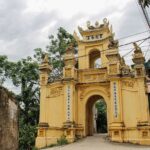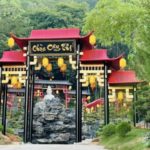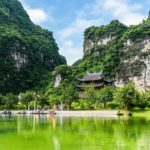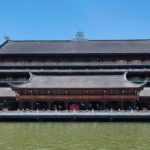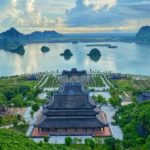Just a short distance away from , visitors can find Phi Lai Di Tang Pagoda, one of the most famous spiritual destinations in Ha Nam. The pagoda attracts tourists not only for its unique architecture and tranquil atmosphere but also for its fascinating historical stories and deep-rooted cultural values.
1 An Overview of Phi Lai Di Tang Pagoda in Ha Nam
Nestled amidst the mountains of Ha Nam, the Phi Lai Di Tang Pagoda (also known as Dung Pagoda) has silently stood for over a millennium. This ancient temple, with its solemn and serene ambiance, nestled against the mountainside, presents a picturesque landscape with green hills on one side and a flowing river on the other.
As visitors step into the pagoda’s compound, they are enveloped in a world of tranquility, a stark contrast to the hustle and bustle of daily life. The temple’s courtyard is covered in white gravel, each tiny stone whispering an invitation to immerse oneself in the surrounding stillness.
 An Overview of Phi Lai Di Tang Pagoda in Ha Nam
An Overview of Phi Lai Di Tang Pagoda in Ha Nam
2 How to Get to Phi Lai Di Tang Pagoda
Travelers from Hanoi can conveniently reach Phi Lai Di Tang Pagoda by motorbike, car, or bus.
-
By Motorbike/Car: Take the Cau Gie – Ninh Binh expressway and then turn onto National Highway 1A at Phu Ly. Follow the signs to Liêm Sơn Commune, and you’ll reach the pagoda.
-
By Bus: You can board a bus at Giap Bat or My Dinh bus station, heading to the Hanoi – Ninh Binh route. Get off at Phu Ly and then take a motorbike taxi or a taxi to the pagoda.
With clear directions and multiple transportation options, visiting Phi Lai Di Tang Pagoda has never been easier.
 How to Get to Phi Lai Di Tang Pagoda
How to Get to Phi Lai Di Tang Pagoda
3 Best Time to Visit Phi Lai Di Tang Pagoda
The pagoda offers distinct experiences throughout the year. In early spring, the temple is adorned with vibrant fresh flowers, creating a joyful atmosphere to celebrate the traditional Lunar New Year. From September to October of the lunar calendar, the pagoda recreates the charming atmosphere of a rural market, offering visitors a glimpse into traditional cultural beauty.
The months of June and July witness the pagoda hosting summer meditation retreats that attract many Buddhist followers. Notably, on the 30th of July in the lunar calendar, the Vu Lan festival and the ceremony honoring Bodhisattva Di Tang are held solemnly. And don’t forget Mid-Autumn Festival, when the pagoda becomes an ideal spot for moon gazing and soaking in the serene ambiance.
 Best Time to Visit Phi Lai Di Tang Pagoda
Best Time to Visit Phi Lai Di Tang Pagoda
4 The History of Phi Lai Di Tang Pagoda
With a history spanning over a thousand years, Phi Lai Di Tang Pagoda (formerly known as Dung Pagoda) is one of the most ancient and sacred temples in Ha Nam. The pagoda served as a secluded residence for King Tran Nghe Tong and was also visited by King Tu Duc for prayer.
However, over time and due to wars, the pagoda fell into disrepair. In 2015, it underwent renovation and was renamed, becoming a popular spiritual destination for many visitors. The name “Di Tang Phi Lai” not only expresses reverence for Bodhisattva Di Tang but also evokes the image of an ancient temple nestled in the mountains.
 The History of Phi Lai Di Tang Pagoda
The History of Phi Lai Di Tang Pagoda
5 What Makes Phi Lai Di Tang Pagoda Special?
Serene Ambiance Steeped in Buddhist Peace
Stepping into the Phi Lai Di Tang Pagoda, one enters a realm of tranquility, a world away from the noise and chaos of everyday life. The picturesque landscape, featuring a small lotus pond and lush green trees, evokes a sense of calm and serenity. Notably, the 12 circles drawn on the white gravel with the inscription, “Khổ hải (Sea of Suffering), please head to the shore”, serve as a gentle reminder, guiding visitors towards inner peace.
The lush green space with fruit trees, herbal gardens, and mushroom-growing areas not only provides a source of clean food but also contributes to a vibrant and lively atmosphere. For book lovers, the charming little library within the pagoda offers a chance to discover enriching reads that nourish the soul.
 Serene Ambiance Steeped in Buddhist Peace
Serene Ambiance Steeped in Buddhist Peace
Unique Architectural Features of the Pagoda
Phi Lai Di Tang Pagoda is not just a spiritual architectural masterpiece but also a treasury of unique artistic expressions. The intricate motifs on the tiles, featuring lotuses, dragons, and phoenixes, reflect the aesthetic beauty of the Ly and Tran dynasties. Notably, the lotus petals with upward-pointing tips and the tiles shaped like the mythical Garuda bird lend a distinct character to the temple.
The architectural design of the pagoda harmoniously blends with nature, resulting in a unique complex. From the solemn Main Hall housing the statue of Bodhisattva Di Tang to other shrines like the Duc Ong and Duc Thanh Dao Hien Halls, each structure boasts its own allure. The Phu Dong Tower atop Phi Lai Mountain, serving as the resting place for 40 generations of monks, further enhances the pagoda’s sanctity and grandeur.
 Unique Architectural Features of the Pagoda
Unique Architectural Features of the Pagoda
6 Things to Keep in Mind When Visiting Phi Lai Di Tang Pagoda
Here are a few things to keep in mind when planning a visit to Phi Lai Di Tang Pagoda:
-
You can contact the pagoda in advance to arrange for a vegetarian meal. Enjoying a vegetarian meal in the peaceful setting of the pagoda is sure to be a memorable experience.
-
Don’t miss the opportunity to hike the mountain behind the pagoda to take in breathtaking panoramic views. Every step reveals a new and exciting discovery.
-
Ha Nam boasts several other captivating destinations, such as Tam Chuc Pagoda and Nui Cam Mountain. Plan your trip to explore all that this region has to offer!
 Things to Keep in Mind When Visiting Phi Lai Di Tang Pagoda
Things to Keep in Mind When Visiting Phi Lai Di Tang Pagoda
With its ancient beauty and sacred aura, Phi Lai Di Tang Pagoda is undoubtedly one of the most alluring destinations in Ha Nam. If you seek a place to unwind, immerse yourself in culture, and explore spirituality, this pagoda is an ideal choice.

























